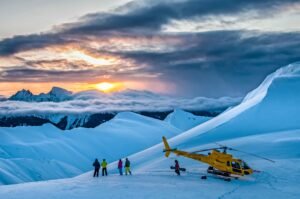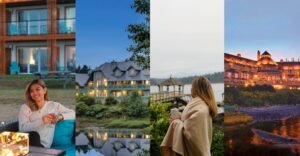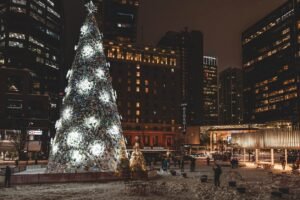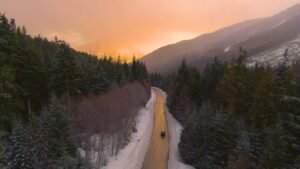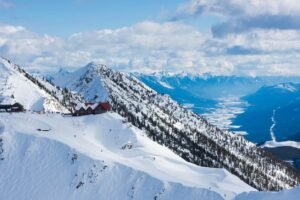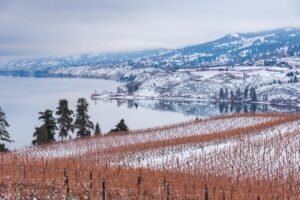Joffre Lakes BC is a must-visit destination featuring three glacier-fed lakes with stunning turquoise waters, ideal for hiking and photography. Located near Pemberton, this guide will provide essential tips, highlights, and what to expect when you visit these breathtaking lakes.
Key Takeaways
-
Joffre Lakes Provincial Park, near Pemberton, BC, is renowned for its three picturesque turquoise lakes set against alpine scenery, making it a popular destination for hiking and photography.
-
Access to the park requires planning, with a mandatory day-use pass starting May 16, 2024. Additionally, early arrivals are recommended to secure parking before it fills up, especially on weekends and holidays.
-
The 9.2 km Joffre Lakes Trail offers challenging yet rewarding hikes with steep, rugged paths leading to Lower, Middle, and Upper Joffre Lakes, each providing unique and breathtaking views ideal for various outdoor activities.
Exploring Joffre Lakes BC: Essential Tips and Highlights

A short drive from Pemberton, British Columbia, takes you to the natural wonder that is Joffre Lakes Provincial Park. Famed for its three turquoise lakes—Lower, Middle, and Upper Joffre—each lake presents its own unique experience and vista. Situated off Duffey Lake Road, the park is a convenient destination for both day trips and weekend excursions.
The surreal blue color of the lakes, a result of glacial silt reflecting sunlight, is a sight to behold. Photographers flock to capture the vivid hues against the backdrop of snow-capped mountains and lush forests. Whether you’re hiking the Joffre Lakes Trail or simply enjoying a picnic by the water, the park’s breathtaking alpine scenery is sure to leave a lasting impression.
Introduction
Joffre Lakes is a beloved destination for hikers and campers, renowned for its challenging yet immensely rewarding trails. The hike to see the three lakes is not for the faint of heart, but the stunning scenery at each lake makes every step worth it.
Don’t forget to pack essentials such as food, water, and toilet paper to guarantee a comfortable and safe journey.
Discovering Joffre Lakes Provincial Park
Joffre Lakes Provincial Park, located near Pemberton, British Columbia, is a haven for outdoor enthusiasts in British Columbia Canada. The park is best known for its three turquoise lakes—Lower, Middle, and Upper Joffre—which are fed by glaciers and surrounded by towering peaks and lush forests. Each lake offers a unique perspective of the park’s stunning natural beauty, making Joffre Lakes a must-visit destination.
Visitors to Joffre Lakes Provincial Park can enjoy a variety of activities, including:
-
Hiking the well-maintained trails
-
Photographing the vibrant blue waters and majestic glaciers
-
Exploring the backcountry campground
-
Taking in the spectacular alpine scenery with vivid blue lakes created by glacial silt and sunlight reflecting off the water
Whether you’re an avid hiker or simply want to enjoy the views, Joffre Lakes Provincial Park has something for everyone.
How to Get to Joffre Lakes
Joffre Lakes Provincial Park is conveniently located about 190 kilometers from Vancouver, making it an accessible destination for a day trip or weekend adventure. Whether you’re driving from the city or taking advantage of shuttle services, reaching the park is straightforward.
Typically, a car ride from Vancouver takes approximately three hours, with scenic views to enjoy during the trip.
Driving Directions
To get to Joffre Lakes from Vancouver, follow these steps:
-
Head west on Highway 1 (Trans-Canada Highway) until you reach Horseshoe Bay.
-
Take Highway 99 north in the direction of Whistler and Pemberton.
-
Enjoy the stunning coastal and mountain views along the Sea-to-Sky Highway drive, making the ride nearly as rewarding as the destination itself.
To get to Joffre Lakes Provincial Park:
-
Continue past Whistler towards Pemberton.
-
Follow the signs to Joffre Lakes Provincial Park.
-
After passing through Pemberton, stay on Highway 99 for about 30 minutes until you reach Duffey Lake Road.
-
The park entrance is well-marked, and you’ll find parking available at the trailhead.
-
Be prepared for a winding road and keep an eye out for wildlife along the way.
Public Transport Options
While direct public transportation to Joffre Lakes Provincial Park is unavailable for the 2024 season, alternative shuttle services can assist you in reaching the park. Although the Parkbus service from Vancouver is not in operation this year, shuttle services from Whistler and Vancouver serve as convenient alternatives for those without a car.
The shuttle from the Cayoosh parking lot operates every weekend from June 29 until September 29, costing $10 CAD per person on the day, with some seats available online in advance for $7 CAD. This shuttle service is a great option for those looking to visit Joffre Lakes without the hassle of driving and parking at the busy trailhead.
Joffre Lakes Trail Overview
Spanning 9.2 kilometers roundtrip and rising 464 meters in elevation, the Joffre Lakes Trail is a demanding but rewarding hike. This well-kept trail guides hikers through breathtaking alpine scenery in British Columbia, showcasing three glacier-fed lakes, waterfalls, and dense forests. Depending on the time of year and weather conditions, the hike can be undertaken as a day trip or an overnight adventure, each offering a unique experience.
The trail is segmented into three parts, each corresponding to one of the Joffre Lakes. It starts with a well-maintained, smooth path leading to Lower Joffre Lake and gradually becomes steeper and more rugged as it climbs towards Middle and Upper Joffre Lakes. Be prepared for a physically taxing hike, particularly in the upper sections where the trail can become slippery and difficult. However, the breathtaking views and sense of achievement make the challenge worthwhile.
Lower Joffre Lake
Lower Joffre Lake is easily accessible, just a five-minute walk from the parking lot, making it an ideal spot for a quick visit or a starting point for the longer hike. The lake’s turquoise waters and surrounding mountain views are breathtaking, providing a perfect introduction to the beauty of Joffre Lakes Provincial Park.
This first lower lake offers a stunning glimpse of what awaits further along the trail, as you make your way towards the upper lake.
Middle Joffre Lake
Middle Joffre Lake, also known as Middle Lake, is a favorite among visitors, known for its stunning scenery and the famous floating log that has become an iconic photo spot. The hike to Middle Joffre Lake, one of the three middle Joffre lakes, is more challenging, involving a steep and rocky climb, but the effort is well worth it. The turquoise waters, surrounded by sub-alpine forests, create a picturesque and serene environment that captivates hikers.
It takes just under an hour to reach Middle Joffre Lake from the parking lot, covering a little over 3 kilometers. For the best photos, aim to arrive around 10 or 11 am when the sunlight enhances the lake’s vibrant color. The floating log provides a unique vantage point for capturing the lake’s beauty, making Middle Joffre Lake a must-see highlight of the trail.
Upper Joffre Lake
Upper Joffre Lake is the most challenging section of the trail, involving steep ascents and rugged terrain. The hike from Middle to Upper Joffre Lake includes a short but steep incline, with a significant elevation gain, testing even experienced hikers. However, the effort is rewarded with breathtaking views of a cascading waterfall, Matier Glacier, and the surrounding peaks.
The final stretch to Upper Joffre Lake offers stunning vistas overlooking Middle Joffre Lake, Holloway Falls, and a backcountry campground. The views of Matier Glacier and Joffre Peak are truly spectacular, providing a perfect backdrop for photos and a sense of accomplishment. At the end of the trail, you’ll find a wooden bear sculpture believed to bring good luck, adding a charming touch to the hike’s end.
Best Time to Visit Joffre Lakes
The best time to visit Joffre Lakes is from July through September, with August being the most photogenic month. During this period, the weather is generally ideal, and the lakes are at their most vibrant. However, this also means that the park can get quite crowded, especially on weekends and holidays. To avoid the crowds, consider visiting mid-week or starting your hike early in the morning.
While Joffre Lakes Provincial Park is open year-round, conditions can vary significantly with the seasons. In the summer, visitors can expect encounters with black flies and mosquitos, so it’s advisable to bring insect repellent. If you prefer a quieter experience, starting your hike later in the day during the summer months can also be a good option.
Permits and Regulations
Starting May 16, 2024, a complimentary day-use pass is mandatory for access to Joffre Lakes Provincial Park. Initiated in 2021, this pilot program aims to regulate visitor numbers and safeguard the park’s natural and cultural characteristics. You can reserve day-use passes online from 7 am onwards, two days prior to your visit, via the BC Parks website. As only a limited 500 passes are available each day throughout the summer, early planning is necessary.
If you plan to camp at Upper Joffre Lake, a backcountry permit is required. The permit costs $5 and is necessary from May 1st to November 13th. Make sure to:
-
Book your camping permits online up to two weeks in advance, as they can get fully booked quickly.
-
Carry your permit with you at all times during your camping trip.
-
Present your permit upon request by park rangers. Camping without a permit or failing to present it upon request by park rangers can result in fines.
Parking at Joffre Lakes
Securing parking at Joffre Lakes can be daunting due to the park’s fame. Three parking lots are available, including the main lot at the trailhead, an overflow lot across the road, and the Cayoosh parking lot. Even though these lots are relatively large, they tend to fill up early in the day, particularly on weekends and holidays. To ensure a parking spot, try to arrive before 8 am on weekends and 9 am on weekdays.
If you arrive later and find the parking lots full, consider using the shuttle service from the Cayoosh parking lot. This service operates on weekends during peak season and provides a convenient way to reach the trailhead without the stress of finding parking. Always remember to follow the parking regulations and be mindful of the environment to help maintain the park’s pristine condition.
Wildlife and Safety Tips
The park is inhabited by a range of wildlife such as mule deer, black-tailed deer, black bears, and mountain goats. While wildlife encounters can be exciting, it’s paramount to adhere to safety measures. Always have bear spray on hand, make noise to prevent startling animals, and refrain from feeding or approaching wildlife. Correct food and waste storage is key to avoid enticing bears and other animals to your camping site.
Pets are prohibited in the park due to bear activity. It is important to ensure the safety of both the pets and the visitors. This policy helps protect both the wildlife and the environment. Additionally, be prepared for encounters with mosquitos and black flies, especially during the summer months. Using insect repellent can help make your visit more comfortable. Always respect the natural habitat and follow guidelines set by park rangers to ensure a safe and enjoyable experience,.
Camping at Joffre Lakes
Camping at Joffre Lakes gives you a unique chance to immerse yourself in the park’s overnight beauty. The Upper Joffre Lake campground hosts 26 small gravel sites, each equipped with a pit toilet and a bear-proof food storage unit. Remember to bring your own toilet paper and brace yourself for the raw conditions. Camping permits are mandatory and can be reserved online up to a fortnight in advance. Such permits are frequently sought after, so early planning is advisable to guarantee your spot.
While camping is permitted year-round, winter camping is only suitable for well-prepared and experienced campers due to the high risk of avalanches. During the winter months, camping is free, but it’s crucial to be equipped with the necessary gear and knowledge to ensure safety. Always check current conditions and avalanche forecasts before planning a winter camping trip to Joffre Lakes.
Additional Activities
The park caters to a variety of interests with an array of additional activities. For photography enthusiasts, the park’s vibrant blue lakes, glaciers, and lush forests offer endless opportunities for capturing stunning shots. The breathtaking natural scenery serves as an ideal backdrop for both novice and seasoned photographers.
For those looking to cool off, swimming in the glacier-fed lakes is an option, though the water is extremely cold. It’s advisable to stay close to shore and swim at your own risk.
If you have the necessary license, fishing is another activity you can enjoy at Joffre Lakes. The park’s tranquil setting also makes it perfect for wildlife viewing, offering chances to observe a variety of animals in their natural surroundings.
Whether you’re hiking Joffre Lakes, camping, or simply enjoying a day at Joffre Lakes Park, Joffre Lakes offers something for everyone.
Nearby Accommodations
If you’re planning an overnight trip to Joffre Lakes, there are several accommodation options in the nearby towns of Pemberton and Whistler. In Pemberton, you can stay at the Pemberton Valley Lodge, which offers a range of amenities including a pool and hot tub. The Pemberton Hotel is another convenient option, known for its comfortable rooms and central location. For a more personalized experience, consider booking an Airbnb, with listings ranging from cozy cabins to entire homes.
Whistler, just under an hour’s drive from Joffre Lakes, also offers numerous accommodation choices. From the luxurious Fairmont Chateau Whistler to the budget-friendly Whistler Lodge Hostel, there’s something to suit every budget and preference. Airbnb options are also plentiful in Whistler, providing a wide variety of stays to enhance your visit.
Indigenous Heritage
Rich in Indigenous heritage, Joffre Lakes Provincial Park is jointly managed by BC Parks, the Líl̓wat Nation, and N’Quatqua. The Lil’wat community regards the park as a sacred place that provides essential sustenance and cultural value for their survival. The park is traditionally used for:
-
gathering minerals and plants
-
berry harvesting
-
hunting
-
trapping
-
fishing
These practices form an integral part of the cultural heritage of the Indigenous communities.
Since 2018, a joint Visitor Use Management Strategy has been in place to protect the park’s natural and cultural values while enhancing the visitor experience. In 2024, the park will have complete closures on specific dates to support Indigenous cultural celebrations and practices. These closures allow the Lil’wat and N’Quatqua Nations to reconnect with the land and hold events such as Stl’atl’imx Days, summer solstice celebrations, and fall harvesting practices. Visitors are encouraged to respect these closures and the cultural significance of the park.
Winter Hiking and Snowshoeing
In winter, Joffre Lakes Provincial Park turns into a snowy wonderland, only accessible via skis or snowshoes. From November to April, the park is a popular spot for skiers and snowshoers, offering a unique view of its alpine scenery. The trail is usually well-marked, though it can become challenging to follow after dark or during heavy snowfall. To minimize the risk of getting lost or triggering avalanches, it’s recommended to avoid snowshoeing immediately after heavy snowfalls.
Camping at Middle Joffre Lake is recommended during winter, as there is a high avalanche risk at Upper Joffre Lake. It is important to prioritize safety when choosing a camping location. Here are some tips to ensure a safe and enjoyable experience:
-
Always check the current conditions and avalanche forecasts before heading out.
-
Be prepared with the necessary winter gear and knowledge.
-
The parking lot is often buried in snow, so bring headlights for visibility.
-
Winter sunsets in the mountains are very early, so plan accordingly.
-
A small area of the parking lot is plowed for access.
By following these tips, you can have a safe and enjoyable camping experience at Middle Joffre Lake.
Summary
Joffre Lakes Provincial Park is a breathtaking destination that offers something for everyone, from challenging hikes and stunning photography opportunities to serene camping spots and rich cultural heritage. By following the tips and guidelines provided, you can make the most of your visit and create unforgettable memories amidst the park’s natural beauty. Whether you’re exploring the vibrant turquoise lakes, hiking through alpine scenery, or learning about the Indigenous heritage, Joffre Lakes is a place that will leave you inspired and longing to return.
Frequently Asked Questions
When is the best time to visit Joffre Lakes?
The best time to visit Joffre Lakes is from July through September, with August offering the most photogenic views. Enjoy your trip!
Do I need a permit to visit Joffre Lakes?
Yes, you need a free day-use pass to visit Joffre Lakes starting from May 16, 2024, and a backcountry permit if you plan to camp at Upper Joffre Lake.
How can I get to Joffre Lakes without a car?
You can take a shuttle from Whistler or Vancouver to get to Joffre Lakes, as there are currently no direct public transportation options available.
What wildlife can I expect to see at Joffre Lakes?
You can expect to see mule deer, black-tailed deer, black bears, and mountain goats at Joffre Lakes. Be sure to carry bear spray and follow safety precautions for wildlife encounters.
Are there accommodations near Joffre Lakes?
Yes, there are accommodations in Pemberton and Whistler, such as hotels and Airbnb listings. Enjoy your stay!

